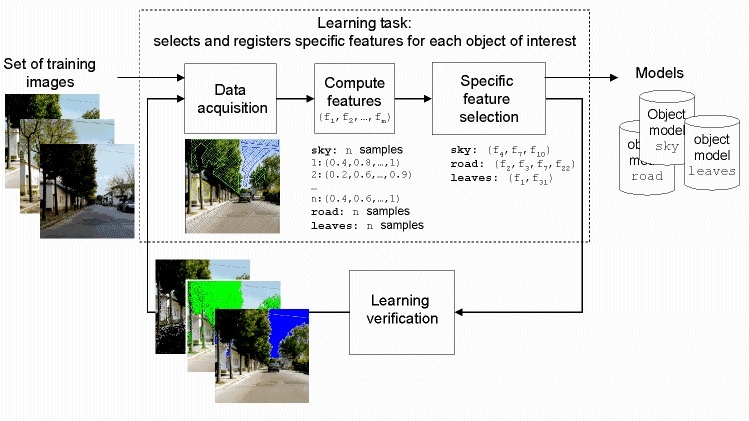 Segmentation
and Scene Description:
Segmentation
and Scene Description:
Learning
as a supervised knowledge acquisition task
Models constitute representations of the
real world, and thus, modelling implies the choice of a suitable set of
parameters in order to build those representations. Obviously, the selection
of the parameters will affect how well the models fit reality, and this
becomes a central issue in any modelling process. Due to the complexity
of some scenes, in our approach we make use of generic modelling to characterize
every object in the scene, but include the possibility that every single
object can be described by specific features, in order to facilitate later
recognition processes.
Object modelling has been designed as a
supervised task, where a teacher presents representative examples of objects
in training images. Each real object is modelled as a set of object
classes. An object class is defined as a prototype of a real
object described in terms of colour and textural features under specific
outdoor conditions. Conscious that not all outdoor conditions can be modelled
for each one of the objects of interest, the system attempts to maximize
outcomes from the available object knowledge. A proper combination of such
classes
will produce a suitable description of the object under any outdoor conditions.
Figure below details the interactive modelling
process, which basically includes:
-
A set of different images, corresponding to
several outdoor conditions, is used to train the system. Three different
attributes are used to define the outdoor conditions: (i) the season, (ii)
the time of day, and (iii) the weather. With the aim of facilitating the
learning task, these attributes can be initialized using linguistic values.
-
Data acquisition. The teacher first selects
meaningful regions representing object classes (i.e., real objects
in specific outdoor conditions). Then, the learning application computes
and registers a number of colour and texture features for each object
class.
-
Feature selection. The learning application
selects a particular subset of features for characterizing each object
class of interest.
-
Learning verification. The learning application
produces a visual feedback for the classes of interest.
 Related
papers
Related
papers
-
J.Freixenet. PhD. Thesis. Descripció d'Escenes Exteriors a partir
d'un Aprenentatge Supervisat de les Característiques més
Significatives dels Objectes. Supervisor: Dr. J. Martí. Presented
in Girona, July 2000.
-
X.Lladó, J.Freixenet, J.Martí. Selecció de Característiques
mitjançant Algorismes Genètics. 3er Congrés Català
d'Intel.Ligència Artificial (CCIA2000), pp. 152-156. Vilanova i
la Geltrú, oct. 2000.
-
J. Freixenet, J.Martí, X.Cufí, and X.Lladó. Use
of Decision Trees in Colour Feature Selection. Application to Object Recognition
in Outdoor Scenes. Proceedings of the IEEE International Conference
On Image Processing (ICIP), vol. 3 pp. 496-499. Vancouver, Sept. 2000.
-
X.Lladó, J.Martí, J.Freixenet, and Ll.Pacheco. A Novel
Criterion Function in Feature Evaluation. Application to the Classification
of Corks. Proceedings of the Quality, Automation and robotics Conference
(Q&A-R 2000), vol. 2, pp. 275-280. Cluj-Napoca, Romania. May 2000.

